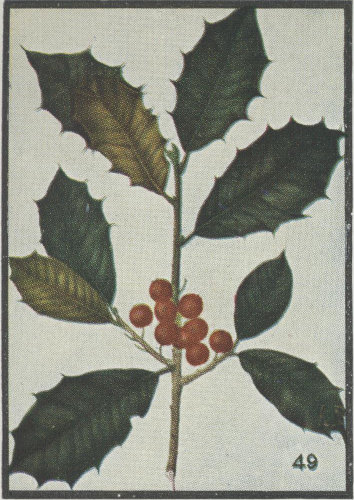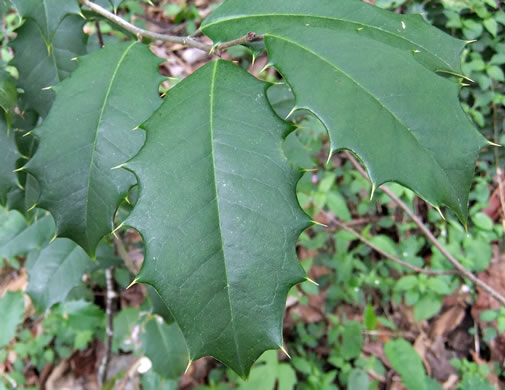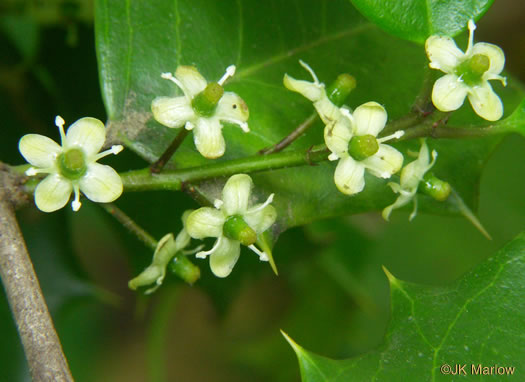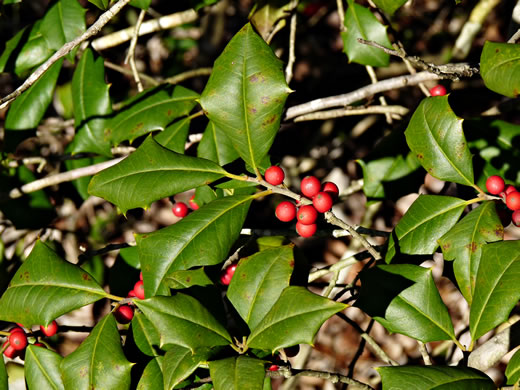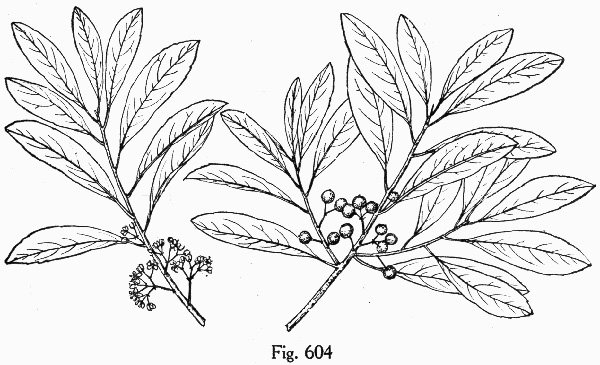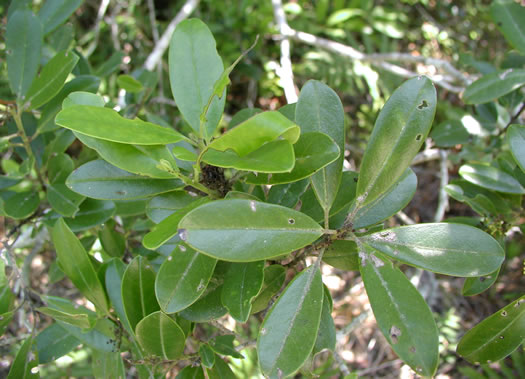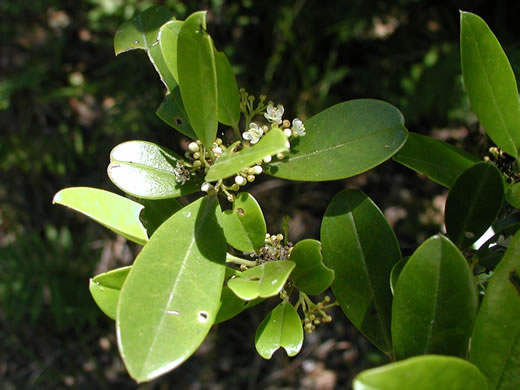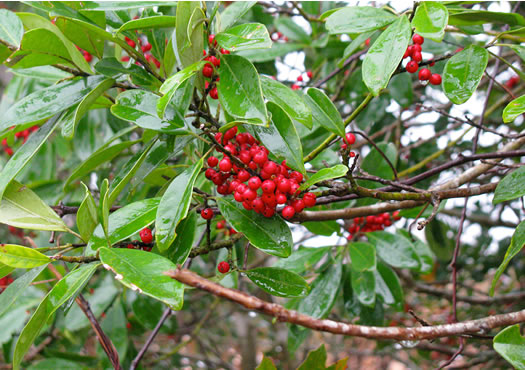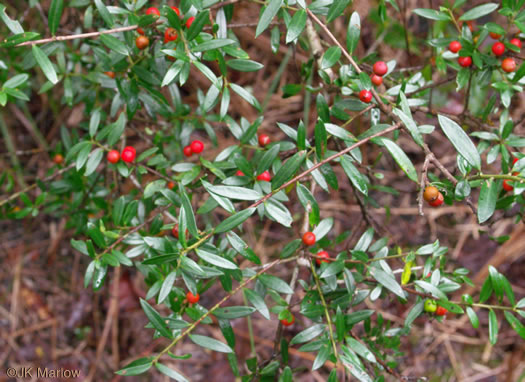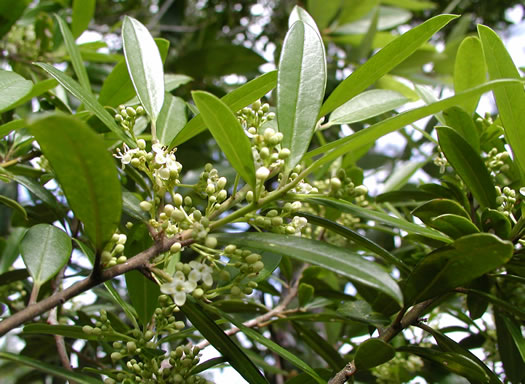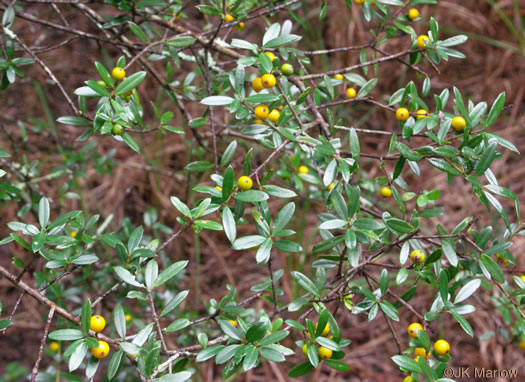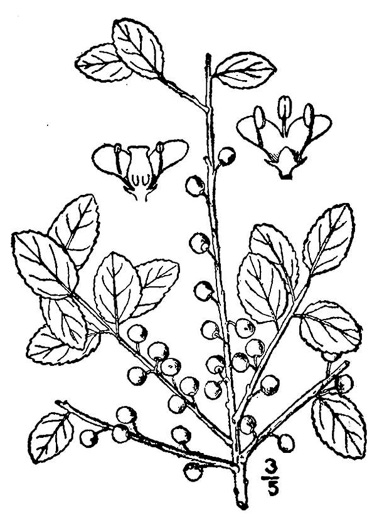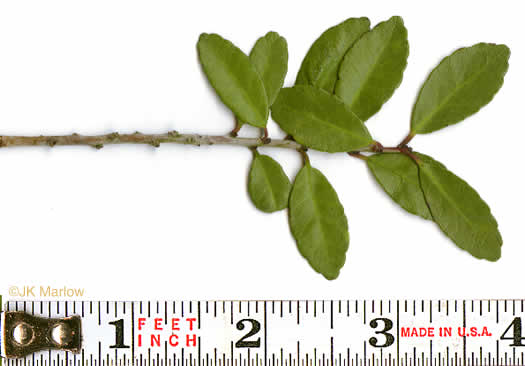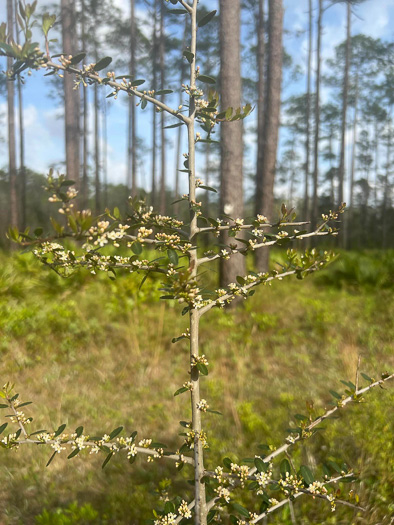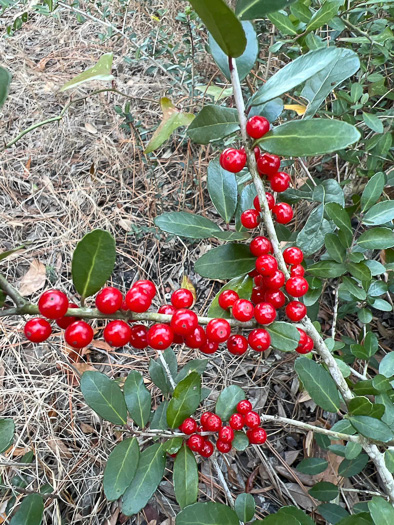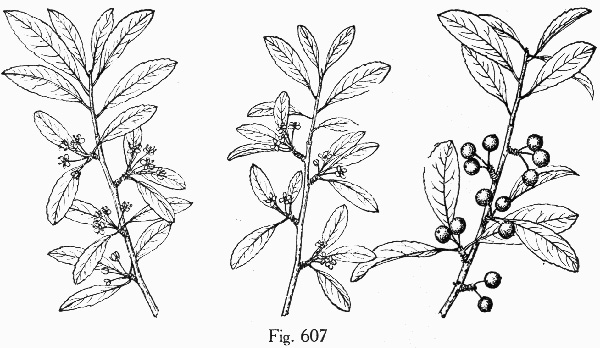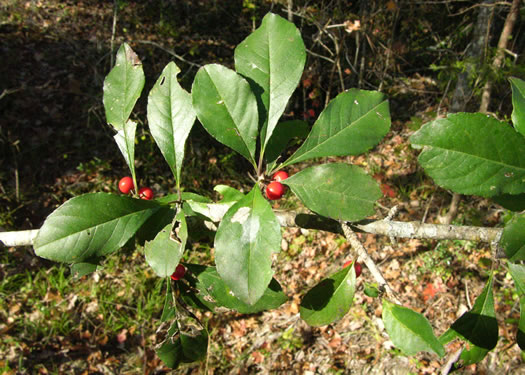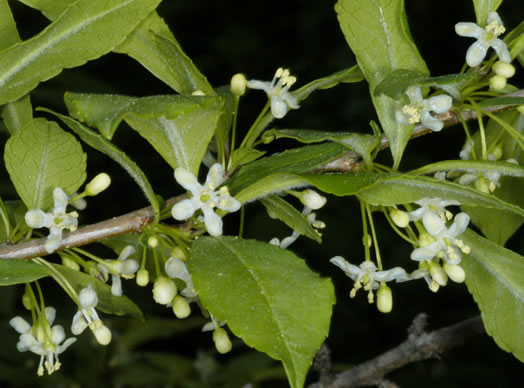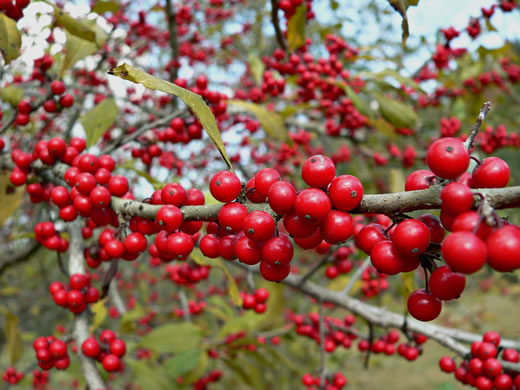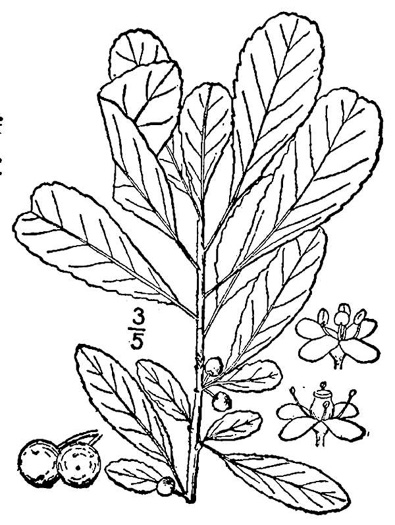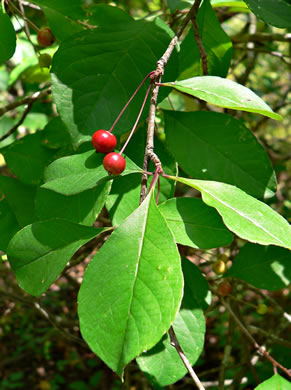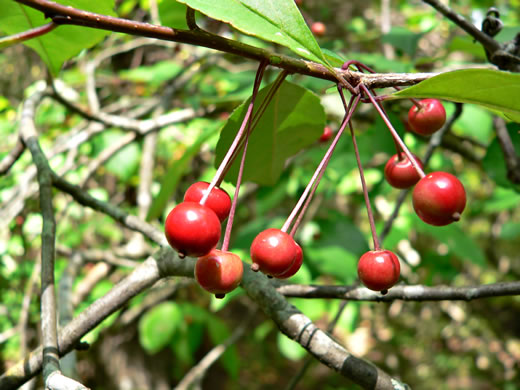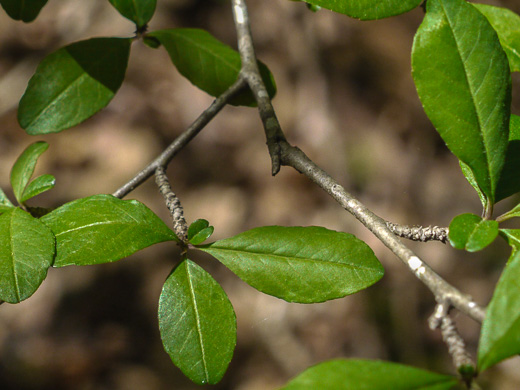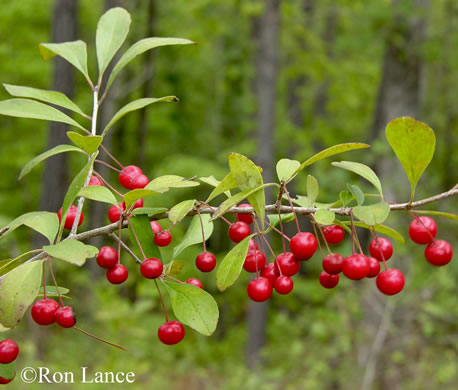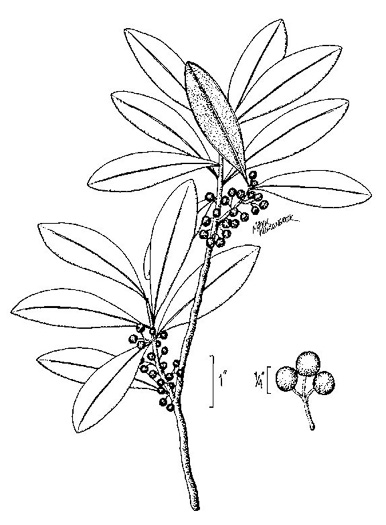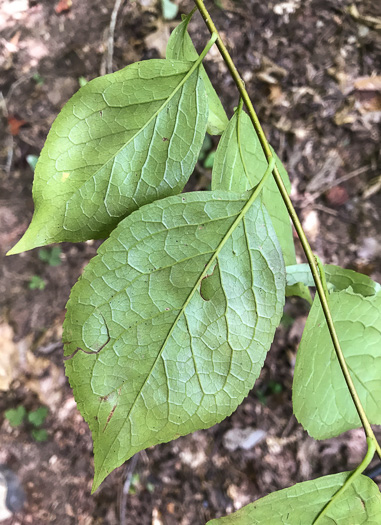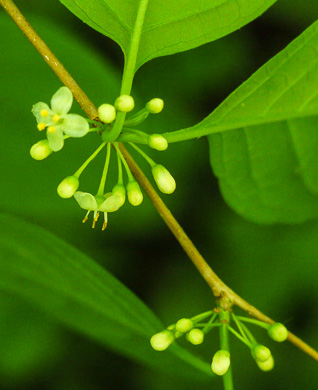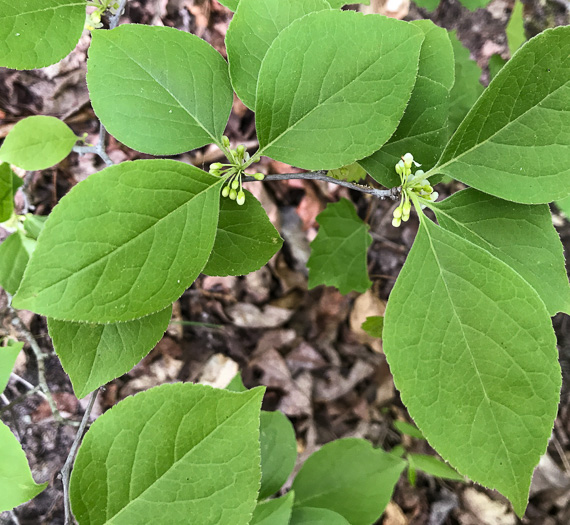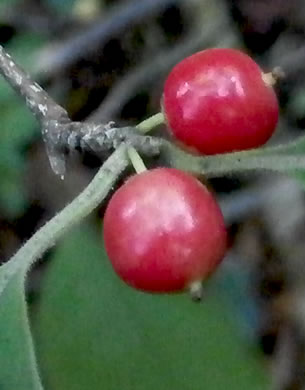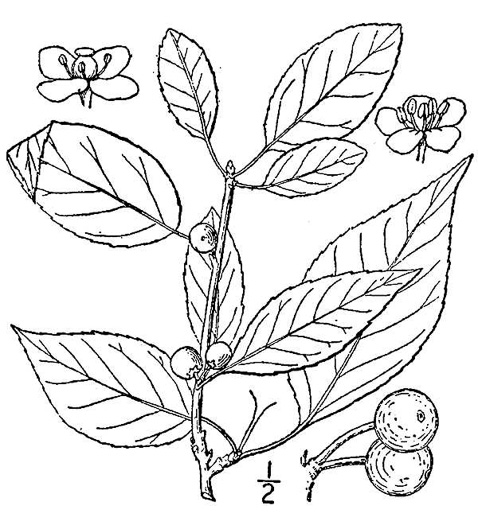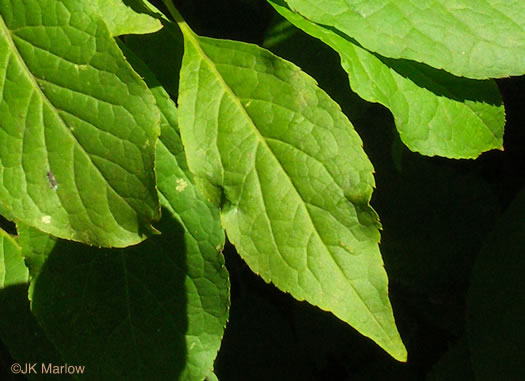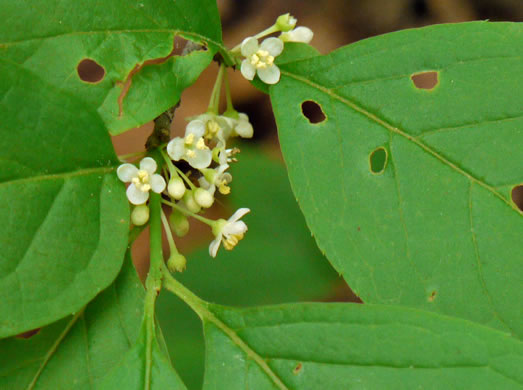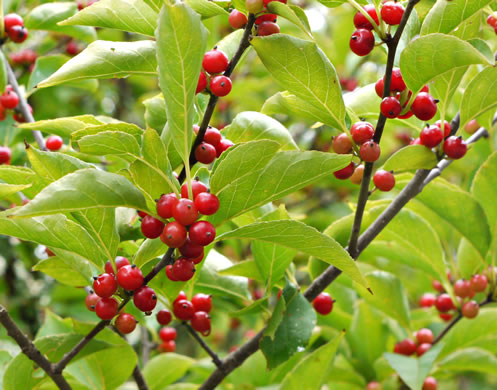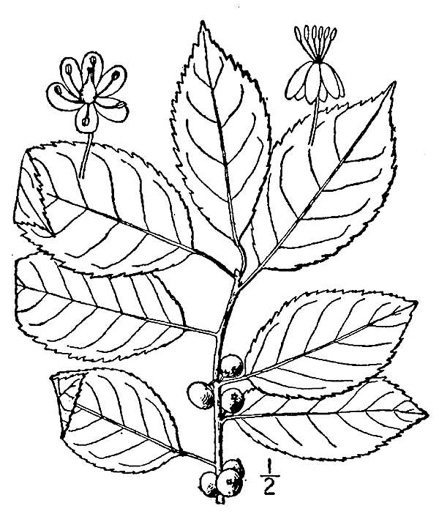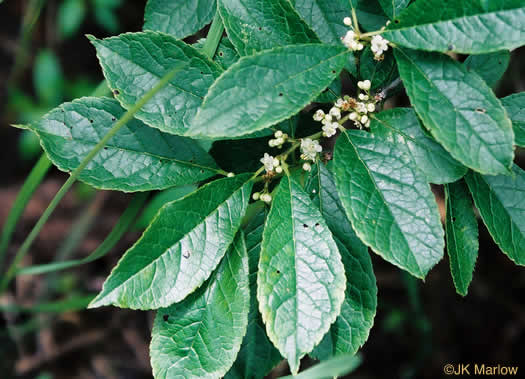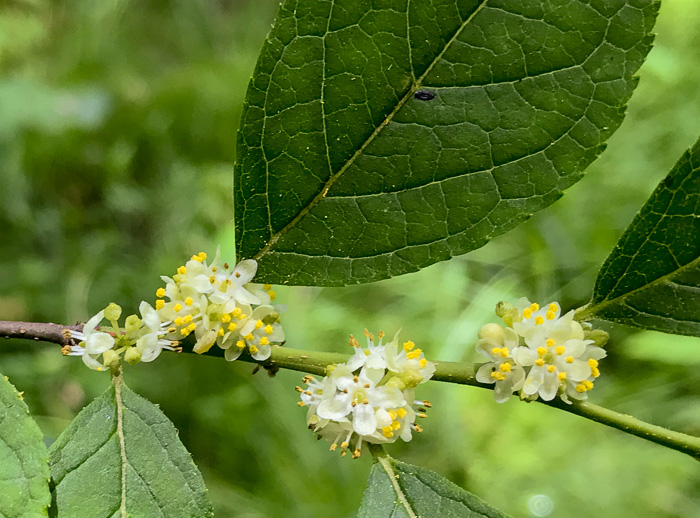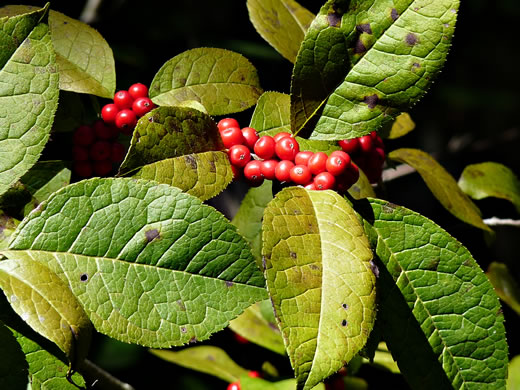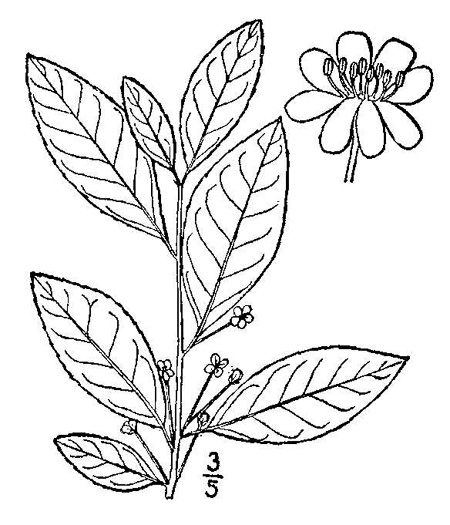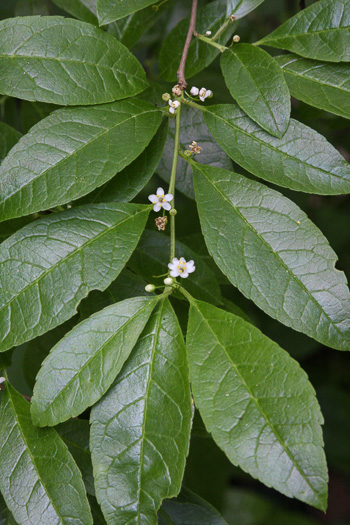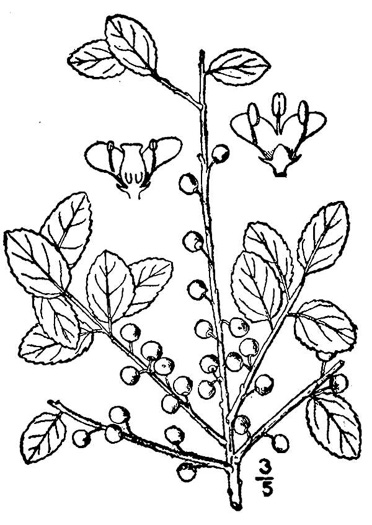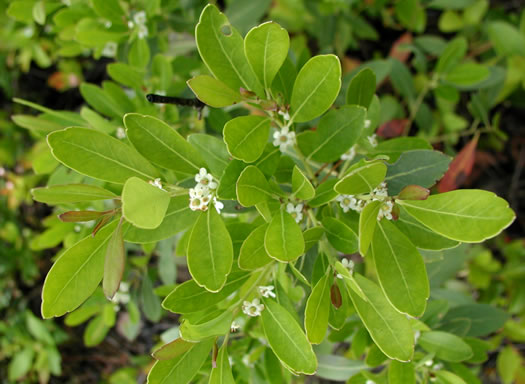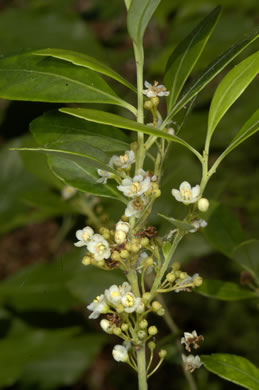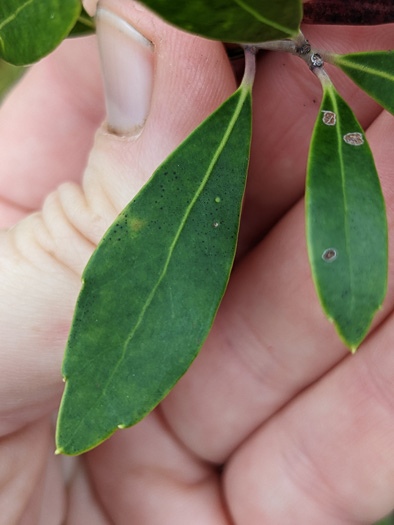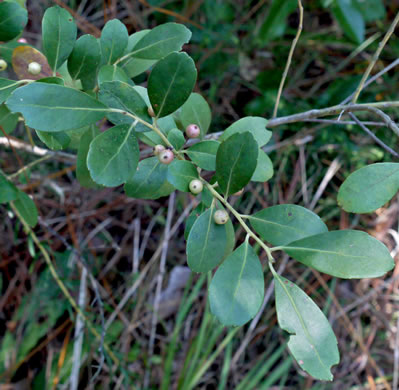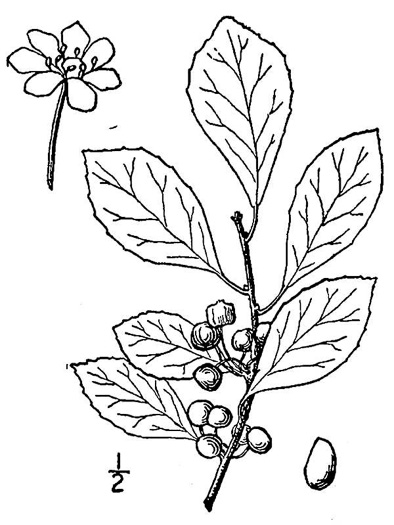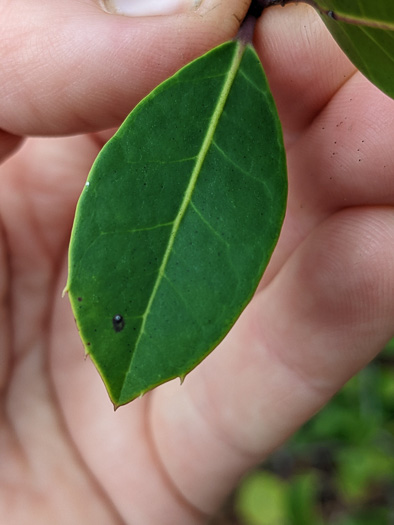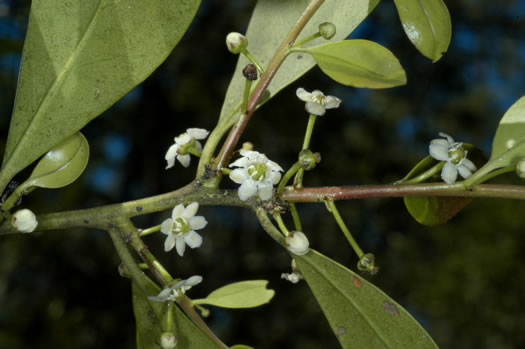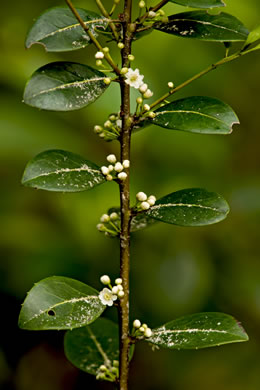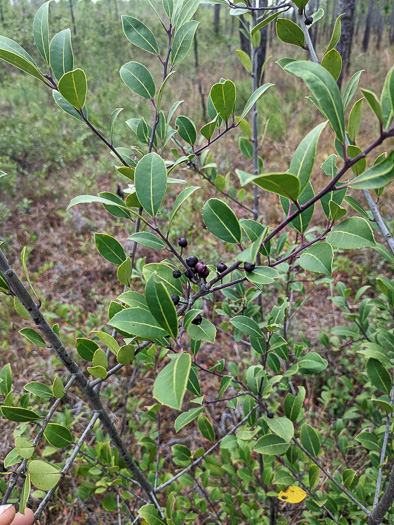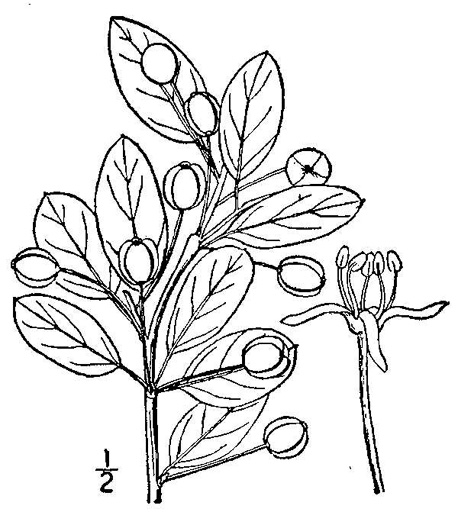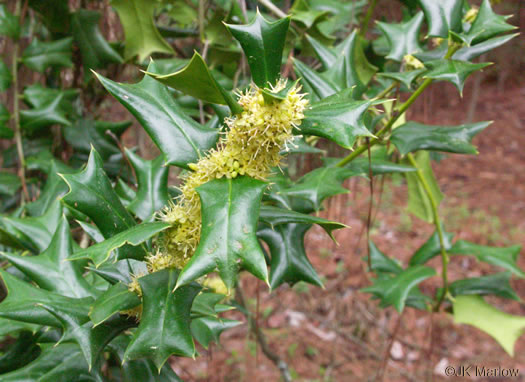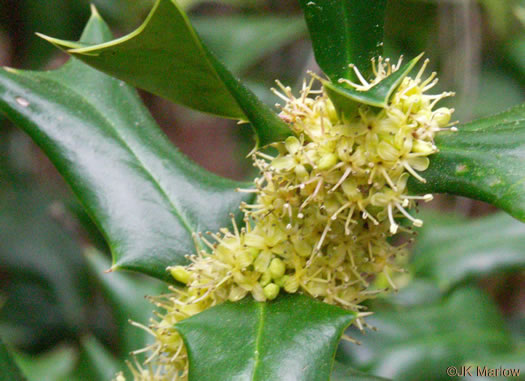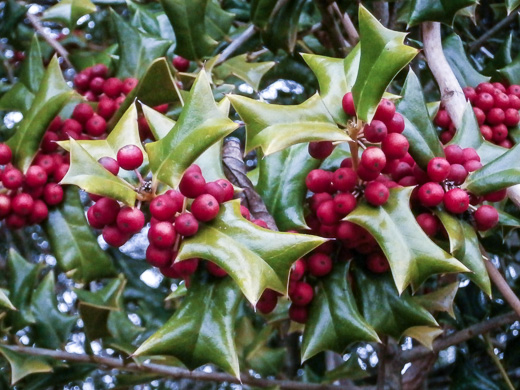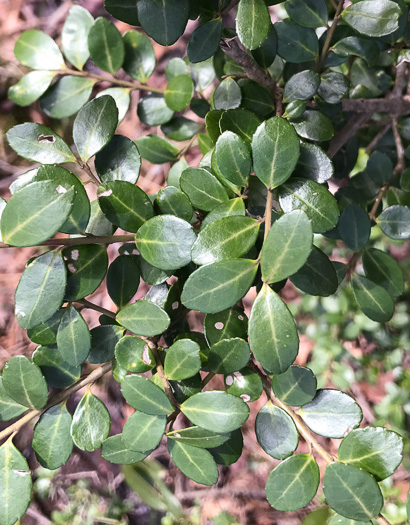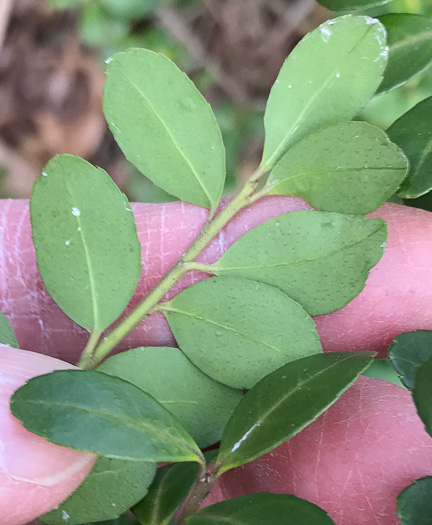Hovering over an image will enlarge it and point out features (works better on desktop than on mobile).
![]() A camera indicates there are pictures.
A camera indicates there are pictures.
![]() A speaker indicates that a botanical name is pronounced.
A speaker indicates that a botanical name is pronounced.
![]() A plus sign after a Latin name indicates that the species is further divided into varieties or subspecies.
A plus sign after a Latin name indicates that the species is further divided into varieties or subspecies.
Most habitat and range descriptions were obtained from Weakley's Flora.
Your search found 19 taxa in the family Aquifoliaceae, Holly family, as understood by Weakley's Flora.

![]()
![]() Common Name:
American Holly, Christmas Holly
Common Name:
American Holly, Christmas Holly
Weakley's Flora: (4/24/22) Ilex opaca FAMILY: Aquifoliaceae
SYNONYMOUS WITH PLANTS National Database: Ilex opaca var. opaca FAMILY: Aquifoliaceae
INCLUDED WITHIN Vascular Flora of the Carolinas (Radford, Ahles, & Bell, 1968): Ilex opaca 112-01-001 FAMILY: Aquifoliaceae
Habitat: In a wide variety of forests, ranging from xeric to wetland
Common
Native to the Carolinas & Georgia

![]()
![]() Common Name:
Dahoon, Cassena, Dahoon Holly
Common Name:
Dahoon, Cassena, Dahoon Holly
Weakley's Flora: (4/24/22) Ilex cassine FAMILY: Aquifoliaceae
INCLUDING PLANTS National Database: Ilex cassine var. cassine FAMILY: Aquifoliaceae
SYNONYMOUS WITH Vascular Flora of the Carolinas (Radford, Ahles, & Bell, 1968): Ilex cassine var. cassine 112-01-002a FAMILY: Aquifoliaceae
Habitat: Blackwater stream swamps, pocosins, nearly always in very acid peaty or sandy sites
Common (uncommon in NC)
Native to the Carolinas & Georgia

![]()
![]() Common Name:
Myrtle Holly, Myrtle-leaved Holly
Common Name:
Myrtle Holly, Myrtle-leaved Holly
Weakley's Flora: (4/24/22) Ilex myrtifolia FAMILY: Aquifoliaceae
SYNONYMOUS WITH PLANTS National Database: Ilex myrtifolia FAMILY: Aquifoliaceae
SYNONYMOUS WITH Vascular Flora of the Carolinas (Radford, Ahles, & Bell, 1968): Ilex cassine var. myrtifolia 112-01-002b FAMILY: Aquifoliaceae
Habitat: Limesink (doline) ponds, pocosins, wet pine savannas
Common in GA & SC (uncommon in NC)
Native to the Carolinas & Georgia

![]()
![]() Common Name:
Yaupon Holly, Yaupon
Common Name:
Yaupon Holly, Yaupon
Weakley's Flora: (4/24/22) Ilex vomitoria FAMILY: Aquifoliaceae
SYNONYMOUS WITH PLANTS National Database: Ilex vomitoria FAMILY: Aquifoliaceae
SYNONYMOUS WITH Vascular Flora of the Carolinas (Radford, Ahles, & Bell, 1968): Ilex vomitoria 112-01-003 FAMILY: Aquifoliaceae
Habitat: Maritime forests, other dry sandy forests, shrublands, and disturbed areas
Common in Coastal Plain (rare in Piedmont)
Native to the Coastal Plain of the Carolinas & Georgia

![]()
![]() Common Name:
Possumhaw, Possumhaw Holly
Common Name:
Possumhaw, Possumhaw Holly
Weakley's Flora: (4/14/23) Ilex decidua FAMILY: Aquifoliaceae
INCLUDED WITHIN PLANTS National Database: Ilex decidua FAMILY: Aquifoliaceae
INCLUDED WITHIN Vascular Flora of the Carolinas (Radford, Ahles, & Bell, 1968): Ilex decidua var. decidua 112-01-004a FAMILY: Aquifoliaceae
Habitat: Floodplain forests, less commonly on mesic (or even dry), upland slopes
Common (uncommon in Mountains)
Native to the Carolinas & Georgia

Common Name: Suwanee Possumhaw, Curtiss's Holly
Weakley's Flora: (4/14/23) Ilex curtissii FAMILY: Aquifoliaceae
INCLUDED WITHIN PLANTS National Database: Ilex decidua FAMILY: Aquifoliaceae
Habitat: Floodplains and moist forests in the Suwanee River drainage
Rare
Native to Georgia

![]() Common Name:
Georgia Holly, Chapman's Holly
Common Name:
Georgia Holly, Chapman's Holly
Weakley's Flora: (4/14/23) Ilex longipes FAMILY: Aquifoliaceae
SYNONYMOUS WITH PLANTS National Database: Ilex longipes FAMILY: Aquifoliaceae
SYNONYMOUS WITH Vascular Flora of the Carolinas (Radford, Ahles, & Bell, 1968): Ilex decidua var. longipes 112-01-004b FAMILY: Aquifoliaceae
Habitat: Upland forests
Uncommon in GA Mountains & GA Piedmont (rare elsewhere in GA-NC-SC)
Native to the Carolinas & Georgia

![]() Common Name:
Cuthbert Holly
Common Name:
Cuthbert Holly
Weakley's Flora: (4/14/23) Ilex cuthbertii FAMILY: Aquifoliaceae
SYNONYMOUS WITH PLANTS National Database: Ilex cuthbertii FAMILY: Aquifoliaceae
INCLUDED WITHIN (PRESUMED) Vascular Flora of the Carolinas (Radford, Ahles, & Bell, 1968): Ilex decidua var. longipes 112-01-004b? FAMILY: Aquifoliaceae
Habitat: Upland circumneutral woodlands and forests
Rare
Native to South Carolina & Georgia

Common Name: Long-stalked Holly, Cherry Holly
Weakley's Flora: (4/24/22) Ilex collina FAMILY: Aquifoliaceae
SYNONYMOUS WITH PLANTS National Database: Ilex collina FAMILY: Aquifoliaceae
Habitat: In peats of bogs and seepages, on banks of cold, high elevation streams (less commonly on moist, rocky slopes in northern hardwood forests or mixed spruce-hardwood forests) at moderate to high elevations (1100-1800m)
Rare
Native to North Carolina & Georgia

Common Name: Sarvis Holly
Weakley's Flora: (4/24/22) Ilex amelanchier FAMILY: Aquifoliaceae
SYNONYMOUS WITH PLANTS National Database: Ilex amelanchier FAMILY: Aquifoliaceae
SYNONYMOUS WITH Vascular Flora of the Carolinas (Radford, Ahles, & Bell, 1968): Ilex amelanchier 112-01-005 FAMILY: Aquifoliaceae
Habitat: Banks of blackwater creeks and rivers, clay-based Carolina bays, other pine flatwoods ponds with seasonally flooded hydrology
Rare
Native to the Carolinas & Georgia

![]()
![]() Common Name:
Carolina Holly
Common Name:
Carolina Holly
Weakley's Flora: (4/14/23) Ilex ambigua FAMILY: Aquifoliaceae
SYNONYMOUS WITH PLANTS National Database: Ilex ambigua FAMILY: Aquifoliaceae
SYNONYMOUS WITH Vascular Flora of the Carolinas (Radford, Ahles, & Bell, 1968): Ilex ambigua var. ambigua 112-01-006a FAMILY: Aquifoliaceae
Habitat: Sandy upland forests, dry slope forests, rarely in pocosin ecotones in the fall-line sandhills region
Common
Native to the Carolinas & Georgia

![]()
![]() Common Name:
Mountain Holly, Mountain Winterberry
Common Name:
Mountain Holly, Mountain Winterberry
Weakley's Flora: (4/24/22) Ilex montana FAMILY: Aquifoliaceae
SYNONYMOUS WITH PLANTS National Database: Ilex montana FAMILY: Aquifoliaceae
SYNONYMOUS WITH Vascular Flora of the Carolinas (Radford, Ahles, & Bell, 1968): Ilex ambigua var. montana 112-01-006b FAMILY: Aquifoliaceae
Habitat: Mesic forests, rarely bogs or bog edges
Common in Mountains (rare in Piedmont)
Native to the Carolinas & Georgia

![]()
![]() Common Name:
Downy Winterberry, "Black Alder"
Common Name:
Downy Winterberry, "Black Alder"
Weakley's Flora: (4/24/22) Ilex verticillata FAMILY: Aquifoliaceae
SYNONYMOUS WITH PLANTS National Database: Ilex verticillata FAMILY: Aquifoliaceae
SYNONYMOUS WITH Vascular Flora of the Carolinas (Radford, Ahles, & Bell, 1968): Ilex verticillata 112-01-007 FAMILY: Aquifoliaceae
Habitat: Bogs, pocosins, swampy forests
Common (uncommon in GA Coastal Plain)
Native to the Carolinas & Georgia

![]()
![]() Common Name:
Smooth Winterberry
Common Name:
Smooth Winterberry
Weakley's Flora: (4/24/22) Ilex laevigata FAMILY: Aquifoliaceae
SYNONYMOUS WITH PLANTS National Database: Ilex laevigata FAMILY: Aquifoliaceae
SYNONYMOUS WITH Vascular Flora of the Carolinas (Radford, Ahles, & Bell, 1968): Ilex laevigata 112-01-008 FAMILY: Aquifoliaceae
Habitat: Pocosins, other wet, acidic sites, such as in small blackwater stream swamps
Common in Coastal Plain
Native to the Carolinas

![]()
![]() Common Name:
Inkberry, Bitter Gallberry, Little Gallberry
Common Name:
Inkberry, Bitter Gallberry, Little Gallberry
Weakley's Flora: (4/24/22) Ilex glabra FAMILY: Aquifoliaceae
SYNONYMOUS WITH PLANTS National Database: Ilex glabra FAMILY: Aquifoliaceae
SYNONYMOUS WITH Vascular Flora of the Carolinas (Radford, Ahles, & Bell, 1968): Ilex glabra 112-01-009 FAMILY: Aquifoliaceae
Habitat: Pine savannas, pine flatwoods, pocosin margins, swamps, primarily in wetlands, but extending upslope even into longleaf pine sandhills, with a clay lens or spodic horizon below to maintain additional moisture
Common in Coastal Plain (rare in Piedmont)
Native to the Carolinas & Georgia

![]() Common Name:
Sweet Gallberry, Big Gallberry, Large Gallberry
Common Name:
Sweet Gallberry, Big Gallberry, Large Gallberry
Weakley's Flora: (4/24/22) Ilex coriacea FAMILY: Aquifoliaceae
SYNONYMOUS WITH PLANTS National Database: Ilex coriacea FAMILY: Aquifoliaceae
SYNONYMOUS WITH Vascular Flora of the Carolinas (Radford, Ahles, & Bell, 1968): Ilex coriacea 112-01-010 FAMILY: Aquifoliaceae
Habitat: Pocosins, more restricted to wet, peaty sites than I. glabra, though very often intermixed in their regions of co-occurrence
Common in Coastal Plain (rare in Piedmont)
Native to the Carolinas & Georgia

Common Name: Catberry, Nemopanthus
Weakley's Flora: (4/24/22) Ilex mucronata FAMILY: Aquifoliaceae
SYNONYMOUS WITH PLANTS National Database: Ilex mucronata FAMILY: Aquifoliaceae
Habitat: Bogs, sedge meadows, high elevation glades, and moist, high-elevation forests
Native north of the Carolinas

![]() Common Name:
Chinese Holly, Burford Holly
Common Name:
Chinese Holly, Burford Holly
Weakley's Flora: (4/24/22) Ilex cornuta FAMILY: Aquifoliaceae
SYNONYMOUS WITH PLANTS National Database: Ilex cornuta FAMILY: Aquifoliaceae
Habitat: Escaped into forests in (primarily) suburban and urban areas, but certain to become more ubiquitous and increasingly in natural areas
Rare
Non-native: China

![]()
![]() Common Name:
Japanese Holly
Common Name:
Japanese Holly
Weakley's Flora: (4/24/22) Ilex crenata FAMILY: Aquifoliaceae
SYNONYMOUS WITH PLANTS National Database: Ilex crenata FAMILY: Aquifoliaceae
Habitat: Planted as a landscaping shrub, escaped into forests in suburban areas
Rare
Non-native: Japan
Your search found 19 taxa. You are on page PAGE 1 out of 1 pages.

